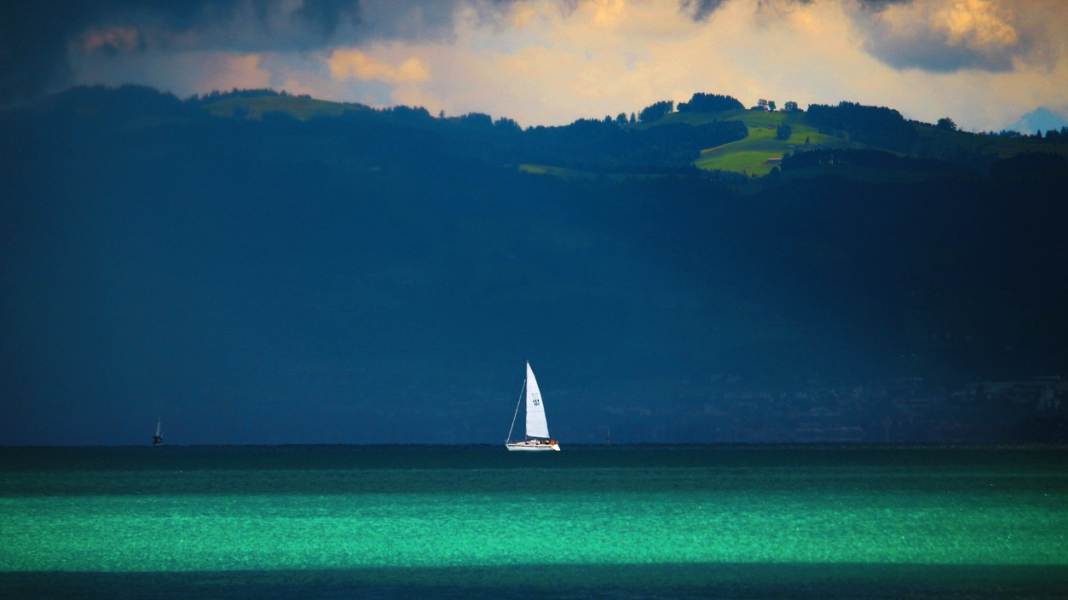Dangerous weather: The storm warning service on the lakes of the Alpine region
Christian Tiedt
· 15.06.2025

The lakes in the Alpine region are particularly popular water sports destinations in summer. Dozens of bodies of water in southern Germany, Switzerland and Austria attract kiters, surfers, sailors and motor boaters in summer. However, the weather can change quickly due to special conditions and can be quite dangerous in extreme events.
For this reason, there is a storm warning service that uses a visual signalling system to indicate imminent dangerous situations, the storm warning lights. Not only guests need to be familiar with their function. In the summer season, two particular weather conditions in particular ensure that the storm warning service is activated: Thunderstorms and foehn winds.
Short warning times for heat storms
Thunderstorms are nothing unusual in summer. They occur when a cold front passes through at the front or as localised warm thunderstorms. A frontal thunderstorm often results in heavy, torrential rain or hail showers. They are usually accompanied by gusty winds that can reach gale force.
Thermal thunderstorms, on the other hand, usually develop as individual cells, recognisable by the typical tower-shaped cumulonimbus cloud. In the Alpine region, these thunderstorm cells can form at particularly high speed in summer and increase in height, meaning that the storm warning service often only has a short warning time before the first gusts occur.
Föhn storm: danger despite blue skies
Föhn winds can also lead to warning situations and can develop into storms under certain conditions. Föhn occurs when a low-pressure area north of the Alps meets a high-pressure area south of the Alps. The air flowing northwards loses its moisture on the southern flanks of the mountains, falls back down on the lee side of the ridges, warms up and ensures clear visibility under mostly blue skies.
The foehn storm can occur suddenly and turn calm conditions into the opposite in minutes when the first gusts sweep over the water. They can reach hurricane force. In addition, there is a short, steep wind sea within a short time. In larger bodies of water with a corresponding fetch, a metre-high wave can even build up. Due to its orientation, the eastern part of Lake Constance is particularly susceptible to this weather event.
The new book by Nicola Möckli provides further detailed information on the weather for water sports enthusiasts in the Alpine region: "Weather on the lake".
The storm warning service on Lake Constance
As an international body of water, Lake Constance in the border triangle of Germany, Switzerland and Austria has a standardised warning system: several dozen orange warning lights have been installed along the shores of Obersee, Untersee and Überlinger See, so that theoretically at least one signal is visible from every position on the water.
The entire lake is divided into three warning areas: west (west of the Constance-Meersburg line), centre (east of the Constance-Meersburg line and west of the Arbon-Langenargen line) and east (east of the Arbon-Langenargen line). From 1 April to 31 October, the system is active from 6 a.m. to 10 p.m., sometimes even longer during major events.
Orange flashes: standardised warning signal
The storm warning service takes place in two stages: strong wind warning and storm warning.
- Strong wind warning (40 flashes per minute): There is a risk of gusts of wind with speeds between 25 and 33 knots (or 46 to 61 kilometres per hour or 6 to 8 Beaufort, i.e. strong to gale-force winds).
- Storm warning (90 flashes per minute): There is a risk of storm winds with speeds of 33 knots or 61 kilometres per hour (8 wind forces on the Beaufort scale).
As soon as the signals are activated, all skippers must initiate appropriate measures to ensure continued safety, such as preparing their boat accordingly or, if necessary, travelling to the next port as quickly as possible.
The storm warning service on the Bavarian lakes
In Bavaria, the same rules generally apply for the storm warning service as on Lake Constance: the system is two-tiered according to the same guidelines and the visual signals with orange flashes (40 per minute for strong wind warnings, 90 per minute for storm warnings) are also the same.
The waters equipped in this way include the Ammersee, the Starnberger See, the Tegernsee, the Chiemsee and the Schliersee. A complete overview can be found on the website of the Bavarian Ministry of the Interior.
Storm warning in Switzerland and Austria
Switzerland has also implemented the system described above for its numerous lakes. Here the Federal Office of Meteorology (MeteoSwiss) is responsible for the storm warning service in cooperation with the cantonal police forces. In addition to Lake Constance, the bodies of water include Lake Geneva, the Jura lakes, Lake Zurich and Lake Lucerne.
In Austria, orange storm warning lights are also used, but not with quite the same standardised system as in Germany or Switzerland. However, the principle is the same: If the lights are switched on, it can be dangerous as far as the wind is concerned. The regulation for Lake Neusiedl in Burgenland, for example, is two-tiered and therefore identical to that in neighbouring countries. In Salzburg, on the other hand, which includes Lake Wolfgang and Lake Traun in Upper Austria, there is only a single warning level.

